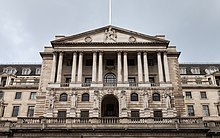almost all countries had adopted the gold standard, backing their legal tender notes with fixed amounts of gold.
After World War II and the Bretton Woods Conference, most countries adopted fiat currencies that were fixed to the U.S. dollar.
The U.S. dollar was in turn fixed to gold. In 1971 the U.S. government
suspended the convertibility of the dollar to gold. After this many
countries de-pegged their currencies from the U.S. dollar, and most of
the world's currencies became unbacked by anything except the
governments' fiat of legal tender and the ability to convert the money
into goods via payment. According to proponents of modern money theory, fiat money is also backed by taxes. By imposing taxes, states create demand for the currency they issue.[17]
Functions
In Money and the Mechanism of Exchange (1875), William Stanley Jevons famously analyzed money in terms of four functions: a medium of exchange, a common measure of value (or unit of account), a standard of value (or standard of deferred payment), and a store of value. By 1919, Jevons's four functions of money were summarized in the couplet:
- Money's a matter of functions four,
- A Medium, a Measure, a Standard, a Store.[18]
This couplet would later become widely popular in macroeconomics textbooks.[19] Most modern textbooks now list only three functions, that of medium of exchange, unit of account, and store of value, not considering a standard of deferred payment as a distinguished function, but rather subsuming it in the others.[4][20][21]
There have been many historical disputes regarding the
combination of money's functions, some arguing that they need more
separation and that a single unit is insufficient to deal with them all.
One of these arguments is that the role of money as a medium of exchange conflicts with its role as a store of value:
its role as a store of value requires holding it without spending,
whereas its role as a medium of exchange requires it to circulate.[22]
Others argue that storing of value is just deferral of the exchange,
but does not diminish the fact that money is a medium of exchange that
can be transported both across space and time. The term "financial
capital" is a more general and inclusive term for all liquid
instruments, whether or not they are a uniformly recognized tender.



No comments:
Post a Comment